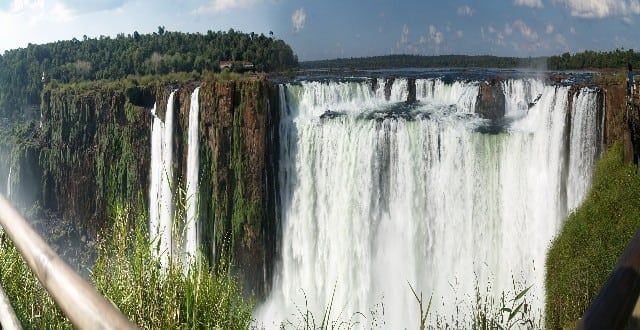Iguazu Falls lie on the Argentina, Brazil and Paraguay border. The falls derive its name from the Guarani word for “great water.” Taller than Niagara Falls and twice its width, the Iguazú Falls are the result of a volcanic eruption. The scenic beauty of the Iguazu Falls is further enhanced by the two national parks which surround it, which are also home to over 2,000 rare and endangered species of flora and fauna.
Shaped like a reverse letter “J”, Iguazu Falls were discovered in 1541 by Alvar Núñez Cabeza de Vaca. It was announced as one of the seven winners of the New Seven Wonders of Nature in 2011.
There are two popular myths associated with the sheer magnanimity of Iguazu Falls. One legend claims that a certain god intended to marry a beautiful woman named Naipí, who fled with her lover Tarobá in a canoe. The god, seething with rage, sliced the river. Thus, the Iguazu Falls came into being.
According to another myth, an enormous snake named “Boi” lived in the river. The aborigines sacrificed a woman every year as an offering to calm his ferocity. However, there was once a brave guarani aborigin who saved the woman from the traditional rite. Boi in rage, bent its body and split the river into charms, thereby separating the man and the woman.
Both the myths serve reimpose the strength and magnanimity of the Iguazu Falls, which was also established as Natural World Heritage Site by UNESCO in 1984. The Iguazu Falls currently has the greatest average annual flow of any waterfall in the world.
When planning a trip to Iguazu Falls, the climatic conditions should be considered cautiously. The months from December to March experience the summer season. This is the hottest and the most humid time of year. What follows is the winter season, when rain is highly likely. These months should specifically be avoided because rainfall would mean that the river can be in high flow which would in turn result in the falls being covered in mist, thereby rendering it difficult to see. Thus, the best times to see Iguazu Falls are in the spring and fall.
Iguazu Falls can be accessed from any of the three cities on the border, namely, Foz do Iguaçu (Brazil), Puerto Iguazu (Argentina) and Ciudad del Este (Paraguay). What makes it hassle free further is the fact that border crossing regulations are relaxed.
Iguazu Falls are divided by various islands into 275 separate waterfalls.The tallest and best known among which is Devil’s Throat, or Gargantua del Diablo. Other notable falls include the San Martin, Bossetti, and Bernabe Mendez.
When visiting Iguazau Falls, it becomes essential to understand that whilst the majority of the falls are in Argentina, a better overview is had from the Brazilian side. So they can plan their tour accordingly. Otherwise, there are two basic circuits which tourists can opt for, an upper path and a lower path. The lower path would lead to the base of the falls, where the spray moistens visitors whereas from the upper path, you can witness panoramic views from the footbridge.’
The sheer immensity, power, beauty and ferocity of the Iguazu Falls is best summed up through Eleanor Rpoosevelt’s remark, “Poor Niagra”.










